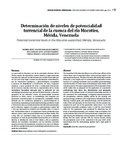Mostrar el registro sencillo del ítem
Determinación de niveles de potencialidad torrencial de la cuenca del río Mocotíes, Mérida, Venezuela
| dc.rights.license | http://creativecommons.org/licenses/by-nc-sa/3.0/ve/ | |
| dc.contributor.author | Rivas, Maribel | |
| dc.contributor.author | Ovalles, Yajaira | |
| dc.contributor.author | Soto, Ana Carolina | |
| dc.contributor.author | Ramírez, Gustavo | |
| dc.contributor.author | Ripanti M., Fabiola | |
| dc.contributor.author | León G., José de J. | |
| dc.date.accessioned | 2010-04-14T22:17:07Z | |
| dc.date.available | 2010-04-14T22:17:07Z | |
| dc.date.issued | 2009-06-30 | |
| dc.identifier.issn | 0556-6606 | |
| dc.identifier.uri | http://www.saber.ula.ve/handle/123456789/30837 | |
| dc.description.abstract | La cuenca del río Mocotíes, uno de los principales afluentes del río Chama, asiento de importantes centros urbanos y región clave para la producción agrícola, ha sido afectada por crecidas torrenciales por ser una zona muy frágil a eventos de precipitación extraordinarios, por las formaciones geológicas y geomorfológicas susceptibles a procesos de degradación y movimientos de masa; ocupación anárquica y poco prudente de áreas e inadecuada intervención de los recursos naturales. Esta área es representativa de los Andes Venezolanos haciéndola adecuada para la aplicación de una metodología paramétrica que permita la determinación y ubicación geográfica de los diferentes niveles de potencialidad torrencial presentes en dicha cuenca. La metodología está integrada por parámetros interrelacionados: la precipitación; estabilidad relativa (definida por las condiciones geológicas y geomorfológicas); la morfometría, expresada por la densidad de drenaje, pendiente media y forma de la cuenca y el índice de protección del suelo representado por la cobertura vegetal; se le asigna a cada parámetro valores del 1 al 6, que representa la condición más favorable (valor 1) hasta la más desfavorable (valor 6). Los parámetros fueron ponderados para obtener cuatro niveles de potencialidad torrencial: Bajo, Medio, Alto y Muy Alto. Los resultados indican que en la vertiente izquierda predomina un nivel de potencialidad torrencial Alto; en la vertiente derecha, la distribución entre el nivel Medio y Alto es equitativo. Además, los resultados coincidieron con los torrentes activados durante el evento de precipitación ocurrido en la cuenca en febrero de 2005, lo cual demuestra que la metodología aplicada tiene un alto grado de confiabilidad. | es_VE |
| dc.language.iso | es | es_VE |
| dc.publisher | SABER ULA | es_VE |
| dc.rights | info:eu-repo/semantics/openAccess | |
| dc.subject | Torrencialidad | es_VE |
| dc.subject | Cuenca hidrográfica | es_VE |
| dc.subject | Precipitación | es_VE |
| dc.title | Determinación de niveles de potencialidad torrencial de la cuenca del río Mocotíes, Mérida, Venezuela | es_VE |
| dc.title.alternative | Potential torrential levels in the Mocotíes watershed, Mérida, Venezuela Rivas, Maribel | es_VE |
| dc.type | info:eu-repo/semantics/article | |
| dc.description.abstract1 | The watershed of the Mocoties River is one of the main affluent of the Chama River, seat of important urban centre and key region in the agricultural production. This place has been affected by big torrential, being this, a very fragile zone to extraordinary precipitation events, because of a geology formations and susceptible geomorphology, anarchic location of certain areas and inadequate intervention of the natural resources. This area is representative of the Venezuelan Andes which makes that as adequate for the application of a parametric methodology that allows the determination and geographic location of the different levels of torrential potentiality presents of this watershed. The methodology is integrated related parameters: the precipitation, relativity stability (define by the geology and geomorphology conditions), the morphometry, indicating by density draining, medium grade, and watershed shape, and the protection index of the soil represents for the forest floor. For this research was assigned for each one of the parameters values from 1 to 6, that represents favourable conditions (value 1) until the most harmful (value 6). The parameters were pondered for obtaining four (4) levels of torrential potentiality: low, medium, high and highest. The results indicate that in the left flowing dominates a high level; in the right flowing the distribution among medium and high is equitable. Beside that the results coincide with the activity torrents during the precipitation event of the watershed in the year 2005, which demonstrate that the methodology applied, had a high grade of reliable. | es_VE |
| dc.description.colacion | 33-41 | es_VE |
| dc.description.email | maribelg@ula.ve | es_VE |
| dc.description.email | ovalles@ula.ve | es_VE |
| dc.description.email | anacarolina733@gmail.com | es_VE |
| dc.description.email | geramirez_11@hotmail.com, gvr1966@yahoo.com.mx | es_VE |
| dc.description.email | ripantif@ula.ve | es_VE |
| dc.description.email | jleong@ula.ve | es_VE |
| dc.description.frecuencia | semestral | |
| dc.publisher.pais | Venezuela | es_VE |
| dc.subject.facultad | Facultad de Ciencias Forestales y Ambientales | es_VE |
| dc.subject.keywords | Torrential | es_VE |
| dc.subject.keywords | Watershed | es_VE |
| dc.subject.keywords | Precipitation | es_VE |
| dc.subject.publicacionelectronica | Revista Forestal Venezolana | |
| dc.subject.seccion | Revista Forestal Venezolana: Artículos | es_VE |
| dc.subject.thematiccategory | Geografía | es_VE |
| dc.subject.thematiccategory | Medio Ambiente | es_VE |
| dc.subject.tipo | Revistas | es_VE |
| dc.type.media | Texto | es_VE |
Ficheros en el ítem
Este ítem aparece en la(s) siguiente(s) colección(ones)
-
Revista Forestal Venezolana - Número 053 - Vol 001
Enero - Junio 2009



